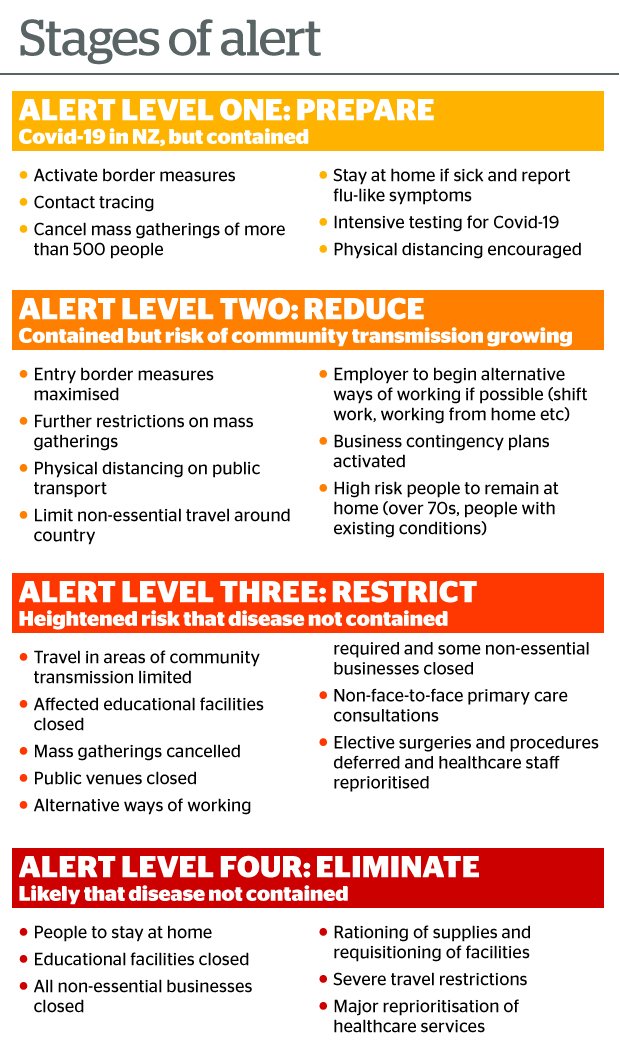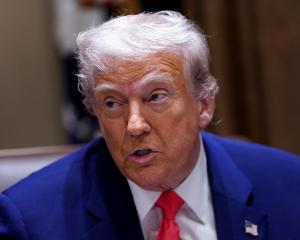Prime Minister Jacinda Ardern has raised New Zealand to alert level three immediately and the country will move to level four in 48 hours.
Ardern said New Zealand faced the potential for devastating impacts, but there was a "small window to get ahead of it".
The measures associated with the alert levels will be in place for four weeks.
- 36 new virus cases; spread in community
- Rents frozen: Govt to prevent landlords raising rents
- Alert level 3: What this means for you
- Flight Centre cuts 250 jobs
- Air NZ to start laying off staff
- Stark picture in worst-case scenario
Schools are to be closed for all except children of essential service workers. Schools will close to all pupils after Wednesday.
"Now is the time to put our plans into action. We are fortunate to be in some way behind the majority of overseas countries in terms of cases ... but act now or risk the virus taking hold."
She said the situation was moving at pace "and so must we".
Meanwhile Finance Minister Grant Robertson said Cabinet decided to do more to cushion the impact of Covid-19.
The wage subsidy would have no cap, so all businesses will be eligible. cost would now be $9.3b, up from $5.1b.

There have been 36 new coronavirus cases in the last 24 hours, bringing the total number in New Zealand to 102 confirmed cases. Two of those cases are now considered community transmission cases.
Ms Ardern said: "If community transmission takes off in New Zealand, the number of cases will double every five days."
That would lead to health systems overwhelmed and the potential for tens of thousands of New Zealand deaths, she said.
"Our plan is simple. We can stop the spread by staying at home and reducing contact. Now is the time to act."
All New Zealanders not in essential services are now being asked to stay at home, but leaving the house for exercise or for a walk was still allowed.
"It must be solitary," she said, and being outside meant keeping a 2 metre distance from others.
People could also go outside with those they shared a house with.
Public transport will only be available for people in essential services, or to move essential goods or people working in essential services.
She said New Zealand was now at alert level 3, effective immediately.
In 48 hours the alert level would be raised to level 4, she said. Essential services would still be open at all alert levels.
She said when people were visiting essential services, physical distancing should still be practiced.
All non-essential services now had to close, she said.
"All indoor and outdoor events cannot proceed. In short, we are all now preparing as a nation to go into self-isolation in the same way we have seen other countries do. Staying at home is essential."
WHAT LEVEL 3 MEANS
Level 3 means limited travel in areas with clusters of Covid-19 cases, affected educational facilities closed, mass gatherings cancelled, public venues closed (such as libraries, museums, cinemas, food courts, gyms, pools, amusement parks), some non-essential businesses closed, and non face-to-face primary care consultations, with non elective services and procedures in hospitals deferred.
Level 4 means people instructed to stay at home, schools and universities closed, as well as non-essential businesses, major reprioritisation of health services, and severely limited travel.
"All indoor and outdoor events cannot proceed. In short, we are all now preparing as a nation to go into self-isolation in the same way we have seen other countries do. Staying at home is essential."
That would give the health system a chance to cope, she said.
WHAT LEVEL 4 MEANS
While in alert level 4, Ardern said contact tracing would continue and testing would go on "at pace" to find out where cases are.
If we flush out cases we already have, and slow down transmission, areas could move out of level 4, she said.
Community transmission had a lag time, and these measures would be in place for at least four weeks, she said.
She repeated that pharmacy products will still be available, and supermarkets would stay open.
Ms Ardern is being joined by Finance Minister Grant Robertson and is also expected to outline the Government's next moves to help businesses and workers through the economic fallout of the Covid-19 outbreak.
NEW ECONOMIC RESCUE PACKAGE
Finance Minister Grant Robertson said that Cabinet decided to do more to cushion the impact of Covid-19.
Businesses less than a year old were now also eligible, as were self-employed people, registered charities, NGOs, and incorporated societies.
The cost would now be $9.3b, up from $5.1b.
He said rents would also be frozen.
The Government had also agreed in principle to guarantee lending to businesses to help their survival. Details were being finalised.
"We are also making urgent preparations for further income support for all workers as we move into alert 4."
He asked workers and firms to talk to each other, to talk to banks, and to make a plan. He said all workers would keep making an income in this period
"We are all in this together."
36 CASES IN 24 HOURS
There have been 36 new cases in the last 24 hours, bringing the total number in New Zealand to 102 confirmed cases. Two of those cases are now considered community transmission cases.
Director-General of Health Dr Ashley Bloomfield earlier said more than half of the new cases were directly related to overseas travel.
"So these are people who have returned to New Zealand recently and have become symptomatic, been tested and confirmed as cases of Covid-19.
"Most of the remaining cases are close contacts of a previously confirmed case or are associated with an event where there were confirmed cases already, for example, the Hereford Cattle conference in Queenstown."
There were still two cases - in the Wairarapa and Auckland - that could not be linked to overseas travel and were being treated as community transmission.
More than 7400 tests have been carried out so far and there were 1100-1500 tests being done every day.
Contacting tracing efforts were being ramped up and the ministry was expecting more cases, Dr Bloomfield said.
"I would expect to see more cases each day."
There were 1100-1500 tests being done each day. About 1-2 percent of those were coming back positive - which was comparatively low compared to other countries, suggesting our rate of testing is reasonably high, he said.














